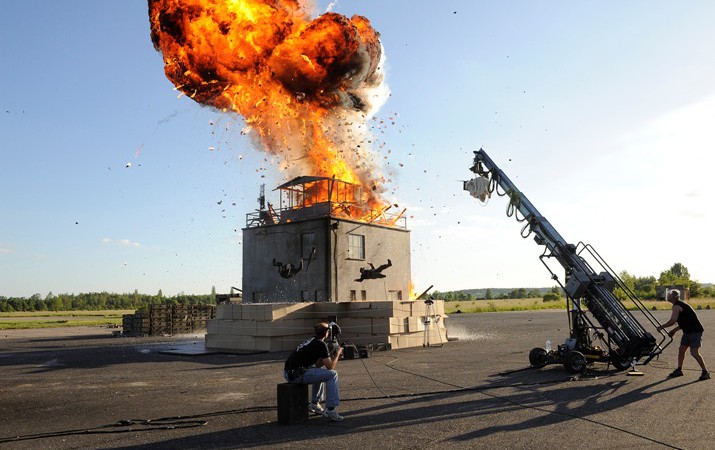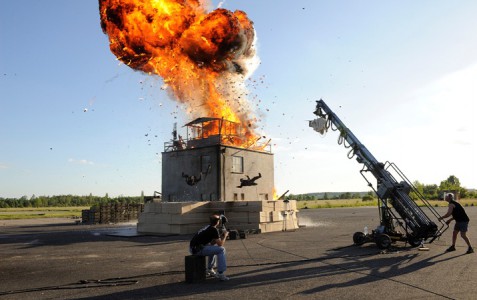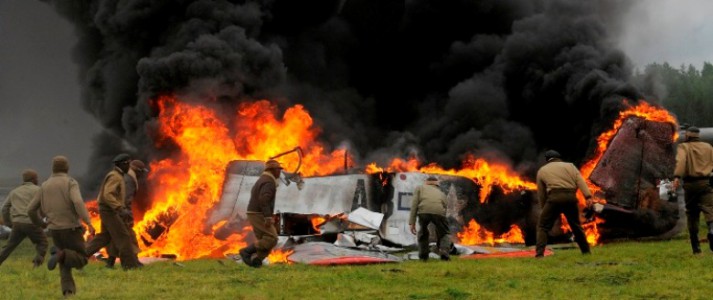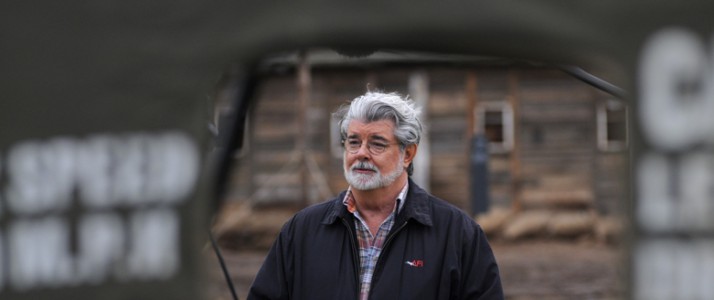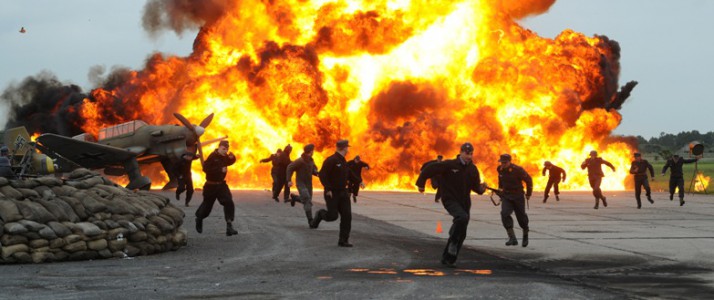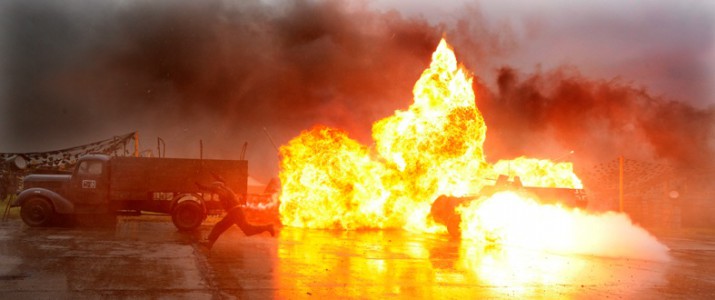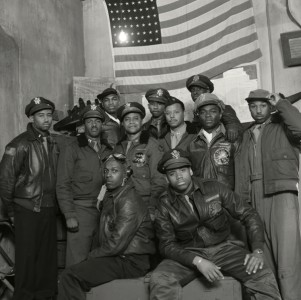The 20-year-old dream to bring the Tuskegee Airmen story to the screen is set to take off, thanks to Czech crew and Soviet-era rundy
More than two decades after George Lucas announced his interest in making Red Tails, a film about the famous group of African-American pilots in World War II known as the Tuskegee Airmen, it has finally been completed, and the offical trailer is now online. Not only was most of the film shot in the Czech Republic, but the visual effects and score were done here as well.
“I am glad we have waited. Films only work for the moment; you have to tap into the zeitgeist of the moment. We’re releasing the film (close to) Martin Luther King’s birthday in January 2012,” producer Rick McCallum told Czech Position. The actual release date is Jan. 20 since Martin Luther King Day falls on a Monday and films are usually released on Fridays. McCallum has worked closely with George Lucas since the early 1990s, overseeing The Young Indiana Jones Chronicles and three complete Star Wars Films as well as the revised versions of the earlier ones.
McCallum described Red Tails as the story of “a remarkable little moment in US history” when a group of college-educated, 20-year-old African Americans had an opportunity to become heroes. The film stars Terrence Howard, Cuba Gooding Jr., Nate Parker and Method Man and is directed by Anthony Hemingway. George Lucas is executive producer and gets a credit for the story, although the screenplay was written by John Ridley. The title refers to markings on the P-51 Mustang fighter planes flown by the Tuskegee Airmen.
While January is an unusual time for an action film – and the film offers one solid hour of visual-effects filled action to one hour of dramatic scenes – McCallum said the film needs some special handling. “We want to take advantage of Black History Month (in February) and Martin Luther King Day… We want this to be an aspirational film for African Americans,” he said, adding that they are targeting a wider audience as well. While he hopes people take a positive message away from the film, he emphasizes it is at its core an action film, as audiences don’t like being lectured.
One problem that held the film back is the scale of the story. There is the Tuskegee part with racism in Alabama; the adventure part in the war in Europe and the civil rights movement when they return. “So when you try to make that one big story, it is just is very hard to film,” he said. In the end, the filmmakers opted for a standard two-hour length rather than an epic.
“So we are doing just the action-adventure part of the guys arriving (in Europe). It was quite ironic; the Italians loved them because they were consummate gentleman… The Germans had the greatest respect for them; when they were shot down and put into camps they were always treated as officers. But (the Germans) couldn’t believe they would continue to fight for the US when they were treated so badly in their own army,” he said, adding that while the pilots were all officers, they were not allowed to use the officers’ clubs in the US Army because the clubs at that time were for whites only due to segregation rules.
The bulk of filming took place in the Czech Republic in 2009. Delays in having the film hit the screen have been related to efforts to keep costs under control, as well as waiting for the right time. “It’s a low-budget film: $30 million is low budget when you have a film that has 1,500 visual effects shots and they are all aerial shots,” McCallum said.
“Normally what you do in a ‘big’ movie is you start the visual effects simultaneously, but what we did is we shot the movie here (in the Czech Republic) in 2009 and then… with a very small Czech crew we kept on shooting the action sequences and the visual effects sequences. We got rid of the main big crew and then concentrated on all the big difficult stuff in 2010. But also at that time we understood politically it wasn’t the most perfect time to bring out a movie like Red Tails, you could just feel it,” he said, citing such factors as controversy over US President Barack Obama’s birth certificate.
“And also we wanted to complete the film, complete the editing before we did a single visual effect. We wanted to… do all the major explosive stuff for as little money as possible because normally you do that with a full crew, and 80 percent of the crew isn’t doing anything. In order to make it more cost conscious we waited. We did the bulk of the part with the actors, then we did everything without the actors, and then we… got everything cut and locked, and then we did the visual effects because that is the most cost efficient way to do it,” he said.
With so many computer-generated visual effects, cost remained an issue. Rather than rely on Industrial Light & Magic, the computer effects firm that has won 15 Oscars, a Czech firm was hired for most of the shots. “Even though (Lucasfilm) owns one of the most famous visual effects companies, I couldn’t afford to use them (for all the shots). So we are using a Czech company called UPP. Francis Coppola introduced me to them; he had made a small film where he needed about 20 to 30 effects… They are doing a substantial number of the shots for Red Tails and they doing a fantastic, incredible job,” he said. Among UPP’s many previous credits are the World War II aviation film Dark Blue World and the TV film Flight 93 about the one of the planes hijacked on 9/11, as well as more recent films such as Salt.
Most of the flying scenes are computer generated. “Truthfully, it’s 10 percent real and 90 percent CGI. The P-51s fly at 450 miles an hour, and there’s only three in Europe at the level where they can fly safely. When the B-17 – the only flying one comes from France – landed at Milovice, one of its engines blew up, and they took five days to fix it,” McCallum said. Milovice, a small airport near Prague that served as the main set for the film, was previously a military base for Soviet troops.
The real planes were used to create templates for the flying scenes. “When you see the movie you’ll see 200 or 300 bombers; we used the real bomber and copied off of that,” he said. In addition, full-scale but nonfunctional models were used on the ground.
The aviation scenes won’t be Star Wars dressed up in a World War II coat. The case is quite the opposite. “We took the ‘Star Wars’ fight scenes from dogfights from World War II. Most people don’t realize that George built that (trench run) sequence in Episode 4 off of dogfights from World War II footage,” he said. “Red Tails is as realistic as we could possibly make it. We want… it to be as believable as possible because otherwise you don’t understand how heroic they are; then it just becomes a fantasy.”
While director Anthony Hemingway did the main shooting in 2009, some of the additional filming in 2010 was done by other members of the Lucasfilm team. Some sources on the Internet speculated that this meant problems with the production, but McCallum angrily dismissed these rumors as baseless. “Our director had an opportunity to do a great HBO series called Treme about New Orleans… It didn’t look like they were going start the new series until we finished, but then (the schedule changed). We didn’t want to make him not be able to have that opportunity (to work on the series),” he said, pointing out that Hemingway got his start on the HBO series The Wire, made by the same creative team as Treme.
“Plus, this was really second unit action stuff,” McCallum said. Only two or three days involved pickup shots with the main actors, which is normal for Lucasfilm. “You cut it together, you see who works together, and you see what you’re missing. … We shot the film in eight weeks, normally a film (is shot in) 12 weeks,” he said, adding that they always knew they would need to tweak some of the dramatic scenes once the film was closer to completion.
Prague lucks out due to open runway
McCallum said it was his decision that Red Tails be made in the Czech Republic. He has a long history working here going back to the Indiana Jones TV series, as well as some family ties. But that didn’t mean it was an automatic choice. “I went everywhere – I went to Romania, I went to all of Eastern Europe, I went to Hungary, I went all over Central Europe,” he said. “Originally, we planned to shoot in Italy, but it was just impossible.”
When the principal photography of Red Tails was made, the Czech Republic had not yet introduced an incentives package like the ones that most rival venues offer. He characterized the time as a “disaster” for the Czech film industry, and statistics show a huge drop in foreign-funded films between 2004 and 2010.
Hungary did offer incentives, as well as new modern studio space. “The problem with Hungary is they don’t have the same skill set as the Czech film industry, so, yes, you get 20 percent off, but you spend it bringing extra people in because they can’t do all the functions,” he said.
“Plus I needed an airport to use as a set within 20 minutes of a major city where I was going to keep the cast,” he said. “I needed a real working runway, and I needed it to be completely empty so I could build my whole set … and Milovice was the only one that I could actually get permission to bring B-17s, P-51s and P-40s in from all around Europe,” he said.
The airport wasn’t a perfect match, though. The terrain was quite different. In the finished film, details such as hills and trees shot in Ramitelli, Italy – where the story takes place – are seamlessly woven into the flat Czech landscape using CGI. “Otherwise you have to start planting olive trees,” he said. Aside from that, a few scenes were made in the US and some in Croatia, where five villages were blended into one location in the film.
Instead of the more famous Barrandov Studios, but he opted to use Prague Studios for the interior shots. “One of the reasons I used it is I don’t really like to shoot in studios because you’re very vulnerable. If another big film comes in you are sharing resources and spaces, whereas the great thing with Prague Studios is you rent the whole thing. You own it. You can keep your stuff there; it’s just your crew,” he said. But he also praised Barrandov Studios for being well-built and world-class. “I spent four years at Barrandov Studios in the early ’90s when I was doing Indiana Jones,” he added.
Other Czech locations included the mental hospital in Prague’s Bohnice neighborhood, which was passed off as both the White House and the Pentagon. The fence was a close match for the one at the White House, he said. He did note the irony of passing off a mental institution for these key US government buildings, considering the entrenched political partisan turmoil in the US right now. The final Czech location used was the municipal theater in Karlovy Vary.
McCallum had a lot of praise for the Czech crew. The film industry since 1989 has been a good training ground, he said. “Now they are as good as anybody in the world. They do the work for less and without many of the restrictive rules we deal with in the states, so that just makes it such a great attractive place to be,” he said.
He took the unusual step of taking his Czech crew with him for the few scenes that needed to be done in the US. “One of the reasons I wanted to take my Czech crew to the United States was I wanted them to see they are just as competent as anybody else in the world if not more so because they have to work with so many fewer resources and with less money,” he said.
An incentive to work here
While the original shooting in 2009 did not qualify for the new Czech film incentives program, the subsequent post-production did. The filmmakers got back CZK 20.45 million back from what was spent in the Czech Republic. The bulk of the refund is due to $6 million spent on visual effects, as well as the money spent recording the soundtrack. He said the experience recording the soundtrack here with Terence Blanchard was “phenomenal.”
McCallum has been an advocate of incentives for a long time, as he believes a strong Czech film industry is a great benefit for the country as a whole. The idea for incentives has been kicked around for the better part of a decade, with the need becoming quite obvious after Hungary adopted an incentives package in 2004.
He attributes the delays in introducing film incentives to Czech politicians often being concerned with their own personal gain while in office and not caring about protecting whole industries that have a wide benefit for other people and the overall economy. Finally, after the industry faced several hard years, people in the government were willing to listen in 2009.
“What I basically said to the government was if you give $100 million in tax incentives, as a round figure, and you get $130 million back, you’ve made $30 million, but most importantly you kept a cultural part of your active life,” he said, pointing out that Czech films do very well at the box office, which is not the case with domestic films in many other countries.
Czech films qualify for incentives as well as foreign-funded ones. Other experts put the return at 18.2 percent, not 30 percent, but the overall impact of any film on the economy – including non-work related spending done by film crews and tourism generated by publicity from a film – is hard to calculate.
McCallum also said that Lucas lobbied for the incentives in relation to his planned Star Wars TV series, asking the government why it wouldn’t want him to come and spend hundreds of millions of dollars over several years, training a whole generation of filmmakers in the process.
Once the commitment was made in 2009 to finally adopt incentives, there was a lot of momentum. “I must say it happened quickly, much quicker than I actually thought. In fact much of the time was the EU trying to decide (if the proposed incentives package met rules for state support),” McCallum said. Final approval came in 2010, and the end result was worth the wait. “I’ve worked in Australia, Germany and states in the United States; this was the most transparent, the easiest and the fairest. The commitment has been great and strong, and the actual process hasn’t been too bureaucratic, so I couldn’t be happier,” he said.
After a long media silence, the next step for Red Tails is to start promoting it. The strategy includes creating a series of trailers that highlight different aspects of the stories. “We feel that this movie is going to appeal to a wide audience from teenage boys and aviation enthusiasts who will love the dogfights and the spectacular P-51 Mustangs to the people who will connect with a story of courage, patriotism and triumph,” he said. “You can’t just sell this like a summer blockbuster; it’s so unusual.”
